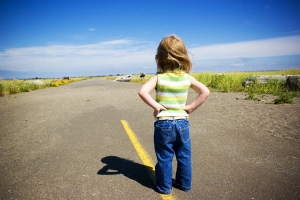Today my six year old child dropped his spoon on the floor whilst we were eating breakfast. Some milk also ended up on the floor. I was annoyed. It wouldn’t have happened if he hadn’t been messing around, I thought.
I thought. I nearly said. But I stopped myself.
He wasn’t ‘misbehaving’. He was just chatting and singing, not sitting still. Being a normal, lively 6 year old boy really. But the old response, the response I grew up with, still sounded in my head, in response to my annoyance.
“Look what you’ve done! Stop messing around and sit still. You always make such a mess.” etc etc.
I could see him looking at me for my reaction, fearing my disapproval. I made a comment about the spoon doing a somersault. He looked relieved and smiled, but he didn’t pick it up immediately. The words ‘Pick it up then’ sounded in my head, but again, I suppressed them. He picked it up a few moments later without prompting.
 I have a general rule that I try to use in these situations. Often I fail, but I try. It is to speak to my child as if he is an adult, a friend or a guest. OK, OK, he’s not any of these things, but does he deserve any less respect?
I have a general rule that I try to use in these situations. Often I fail, but I try. It is to speak to my child as if he is an adult, a friend or a guest. OK, OK, he’s not any of these things, but does he deserve any less respect?
Think about it this way. If you were eating with a friend and they accidently dropped their spoon, what would you say? Certainly none of the words that popped into my head in the above example. And if you did, it would be unlikely you’d remain friends for long.
If you listen carefully, you hear this all the time. My child arrived for his gymnastics class and having signed in with one of the organisers he proceeded towards the gym, but forgot to take his shoes off first. “Take your shoes off then“, the supervisor said.
Not the worst thing in the world, I know, but again, would you speak like this to an adult? Or would you gently say, “Don’t forget your shoes“, or simply, “Shoes“? Why do we habitually speak any less kindly to our children?
The problem is that apart from not being very conducive to building a healthy relationship with our children, these responses communicate a great deal to children, none of it positive. If instead of saying gently, “Don’t forget your shoes”, we say impatiently, “Take your shoes off then”, we don’t just remind our children to take their shoes off, we imply that they’re stupid or forgetful.
Sound over the top? I think not. Believe me, I know. Children are acutely aware of our tone, our moods, our choice of words, and any implications these might have. Not much passes them by. If a child is habitually spoken to in this way all day every day for years, it’s going to have an effect, particularly on self esteem, and again, it’s not a positive one. What’s more, if we want our children to speak respectfully and kindly to others, the number one way we can teach this is by speaking respectfully and kindly to them. Modelling the behaviour we wish to see.
It can take practise and time to change old habits, and like I said, I don’t always succeed. But at least I know if I slip up it’s just that – a slip up. It’s not the way I talk to my child all day every day.
For more on this topic, read Adele Faber & Elaine Mazlish’s “How To Talk So Kids Will Listen & Listen So Kids Will Talk”.



 Posted by Jo
Posted by Jo 










